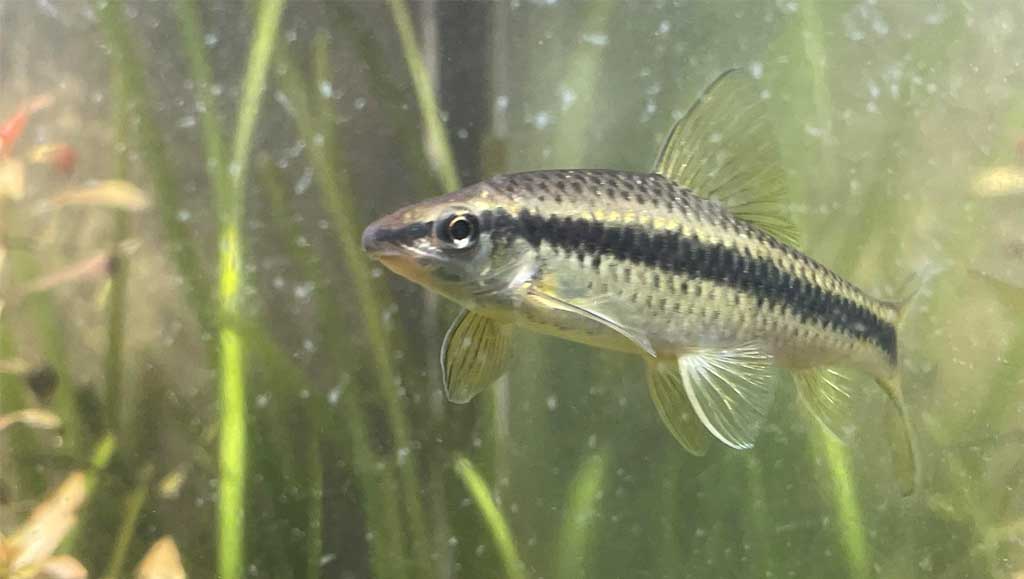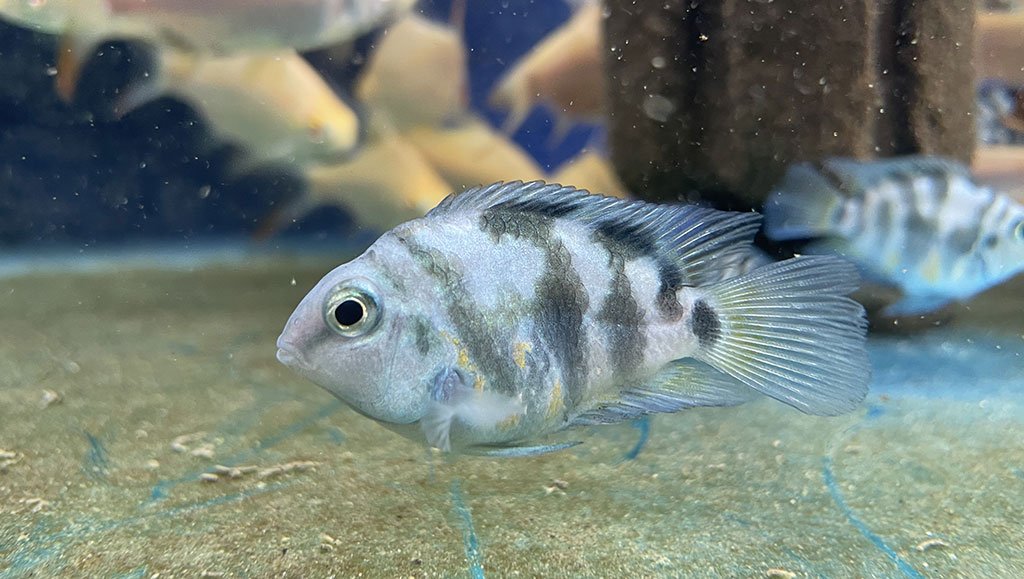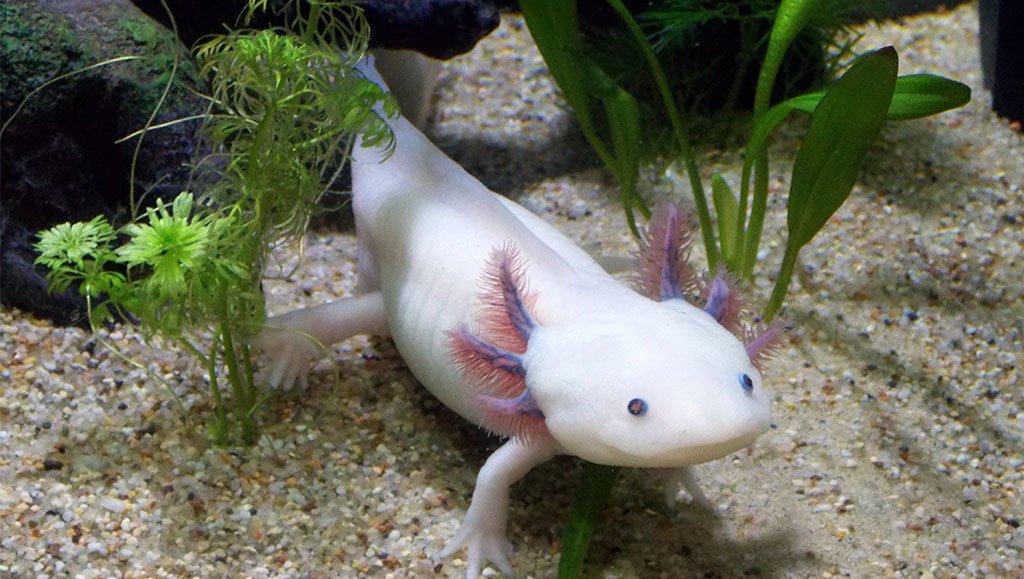Welcome, fellow aquatic enthusiasts! Today, I’m bursting with excitement to share with you everything there is to know about one of the most intriguing and vibrant personalities of the freshwater tank world – the Roseline Sharks.
I’ve had the immense pleasure of nurturing these fascinating beings in my own tank and, my friends, it has been an adventure filled with learning, awe, and a profound appreciation for the beauty nature offers.
Through trial and error, deep dives into research, and countless conversations with fellow aquarists, I’ve gathered a treasure trove of knowledge about caring for these precious jewels.
Whether it’s setting up the perfect tank that mimics their natural habitat, understanding their dietary needs to keep them thriving, navigating the waters of choosing the right tankmates to ensure harmony, or even witnessing the miracle of their breeding, I’m here to guide you every step of the way. Welcome to our deep dive into the world of Roseline Sharks! Get ready to be captivated!
Physical Characteristics and Behavior
Ah, where do we begin with the Roseline Shark, truly a masterpiece of aquatic design! Their elegance and vivid coloration are what initially caught my eye and sparked my enduring passion for these aquatic wonders.
Description of Roseline sharks Appearance
Imagine this – a sleek, torpedo-shaped body gliding through the water, its scales shimmering with a stunning blend of silver, black, and a bold red stripe that runs from their nose to the tail.
It’s this striking color pattern that not only earns them the name ‘Roseline’ but also makes them the centerpiece of any aquarium. Their size, typically reaching around 4-6 inches in adulthood, makes them a perfect fit for a variety of tank sizes.
Behavioral Traits and Social Dynamics
Roseline Sharks are the epitome of grace and dynamism in the aquatic realm. They thrive in groups, displaying a fascinating social structure that’s a joy to observe.
In my tank, I’ve noticed they exhibit a peaceful temperament, mingling well with other species, yet always maintaining a gentle hierarchy within their shoal.
Their playful nature and love for swimming in swift currents bring an undeniable vitality to the tank environment.
Unique Features That Make Them Popular Among Aquarists
It’s not just their dazzling appearance that endears Roseline Sharks to aquarists worldwide. Their adaptability and hardiness make them a joy to care for.
What’s more, their active swimming patterns and sociable behavior contribute significantly to the dynamic ecosystem of a home aquarium, making every moment of observation a delight.
Environmental Sensitivity and Adaptation
From my personal experiences, I’ve observed that Roseline Sharks are quite sensitive to changes in their environment, particularly to water quality and temperature.
This sensitivity, while it may seem a challenge, actually makes them excellent indicators of tank health, encouraging aquarists to maintain high standards of care.
Interaction with Aquarists
Another fascinating aspect of caring for Roseline Sharks is their response to their human caretakers. Over time, I’ve noticed they can become quite comfortable with my presence, often swimming to the front of the tank when I approach, which is incredibly rewarding.
In sharing my experiences with Roseline Sharks, I hope to kindle a spark of interest and love for these magnificent creatures in your heart. Their captivating beauty, intriguing behavior, and the joy they bring to aquarists are truly unparalleled.
Tank Setup and Environment
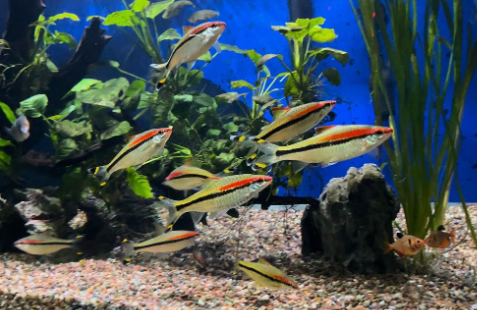
Source: @shamuaquatics
Moving on to one of my favorite parts of the Roseline Shark care guide – the Tank Setup and Environment! Crafting the perfect home for these treasures is not just about aesthetics; it’s about recreating a slice of their natural habitat right in our living rooms.
A well-thought-out tank setup is crucial for their health and happiness. Here’s everything you need to know based on my personal experiences and years of joyful experimentation.
Tank Size and Configuration Recommendations
First off, size does matter when it comes to providing a comfortable home for Roseline Sharks. Based on my experience, a minimum of 55 gallons is essential for a small group, as it gives them ample space to roam, explore, and express their vigorous swimming behavior.
If you have the capacity for a larger tank, by all means, go for it! These fish appreciate the extra swimming length. A rectangular tank shape supports their natural swimming patterns best, simulating the flowing rivers of their natural habitat.
Water Parameters Ideal for Roseline Sharks
Water quality can’t be compromised when caring for Roseline Sharks. They thrive in slightly alkaline, soft to medium-hard water. Ideal water parameters would be a pH level between 6.5 and 7.5, with a temperature range of 72°F to 79°F (22°C to 26°C).
I regularly check the water conditions using a reliable test kit because stable water parameters are key to keeping these beauties healthy and stress-free.
Aquascape and Décor Considerations
Creating a river-like environment will make your Roseline Sharks feel right at home. I use fine gravel or sand substrate, mimicking the riverbeds they’re accustomed to.
Rocks, driftwood, and robust plants, like Anubias or Java Fern, not only add to the aesthetic appeal but provide necessary shelter and break lines of sight, reducing stress among tank inhabitants.
Filtration and Water Movement
Roseline Sharks hail from fast-flowing waters, so incorporating a good filtration system that also provides a moderate to strong current will keep them most content.
Canister filters have been my go-to for maintaining pristine water conditions and simulating their natural river habitat’s current. Just ensure the water flow isn’t too strong for your other tank inhabitants.
Lighting Considerations
While Roseline Sharks are not overly sensitive to lighting, a moderate lighting setup can help simulate the natural daylight cycle and encourage the growth of plants in your tank. I prefer LED aquarium lights with adjustable settings to create a natural ambiance and support photosynthesis in live plants.
Crafting the perfect environment for Roseline Sharks has been a rewarding adventure, filled with learning and endless wonder. Remember, every detail counts in replicating an environment that feels like home to these exquisite fish.
By following these guidelines and adding your personal touch, you’ll create a thriving aquatic ecosystem where your Roseline Sharks can truly flourish.
Feeding Habits and Diet
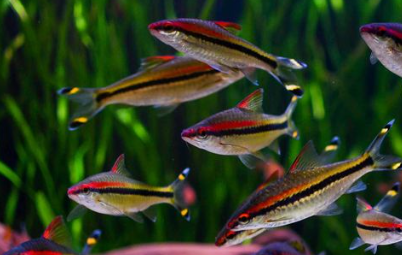
Source: @acuavlogs
Diving into the realm of feeding Roseline Sharks has been an exhilarating part of my aquarist journey. Understanding their dietary requirements is pivotal for their health and vitality. Here’s a peek into my experiences and insights on nurturing them through the right diet.
Natural Diet of Roseline Sharks in the Wild
In their natural habitats, Roseline Sharks are opportunistic feeders, thriving on a diverse menu that includes small invertebrates, algae, and plant matter.
This varied diet is fundamental in providing them with the necessary nutrients for growth and vibrant health. Mimicking this diversity in their diet in captivity ensures they receive a balance of proteins, vitamins, and minerals.
Suitable Foods for Captive Roseline Sharks
Bringing the essence of their wild diet into the aquarium, I’ve found a combination of high-quality flake food, pellets, and frozen or live foods such as brine shrimp or bloodworms works wonders.
I occasionally include blanched vegetables like zucchini slices for added variety and fiber. It’s heartwarming to see them dart across the tank, eagerly exploring and consuming these offerings.
Feeding Schedule and Techniques
Consistency and moderation are key factors in feeding Roseline Sharks. I feed them small amounts two to three times daily, ensuring they can consume all the food within a few minutes to avoid overfeeding and potential water quality issues.
Observing their feeding behaviors provides insights into their health and well-being, making meal times an interactive and enriching experience.
Tips for Optimizing Nutritional Intake
To ensure optimal nutritional intake, I vary their diet throughout the week, incorporating a mix of the foods mentioned. Pre-soaking pellets in water can aid in digestion and prevent buoyancy problems.
Also, monitoring their growth and adjusting food quantities accordingly prevents obesity and maintains their streamlined shape.
Observing Food Preferences and Adjusting Diets
Each Roseline Shark has its preferences and quirks when it comes to food. By attentively observing their reactions to different foods, I’ve tailored their diet to include their favorites while ensuring they get a well-rounded intake of nutrients.
This personalized approach encourages healthy feeding habits and enhances their overall well-being.
Feeding Roseline Sharks is more than just a routine; it’s a fascinating aspect of their care that brings us closer to these magnificent creatures.
Through patience and observation, we can create a dietary regime that not only satisfies their nutritional needs but also enriches their lives in our care.
Tankmates and Compatibility
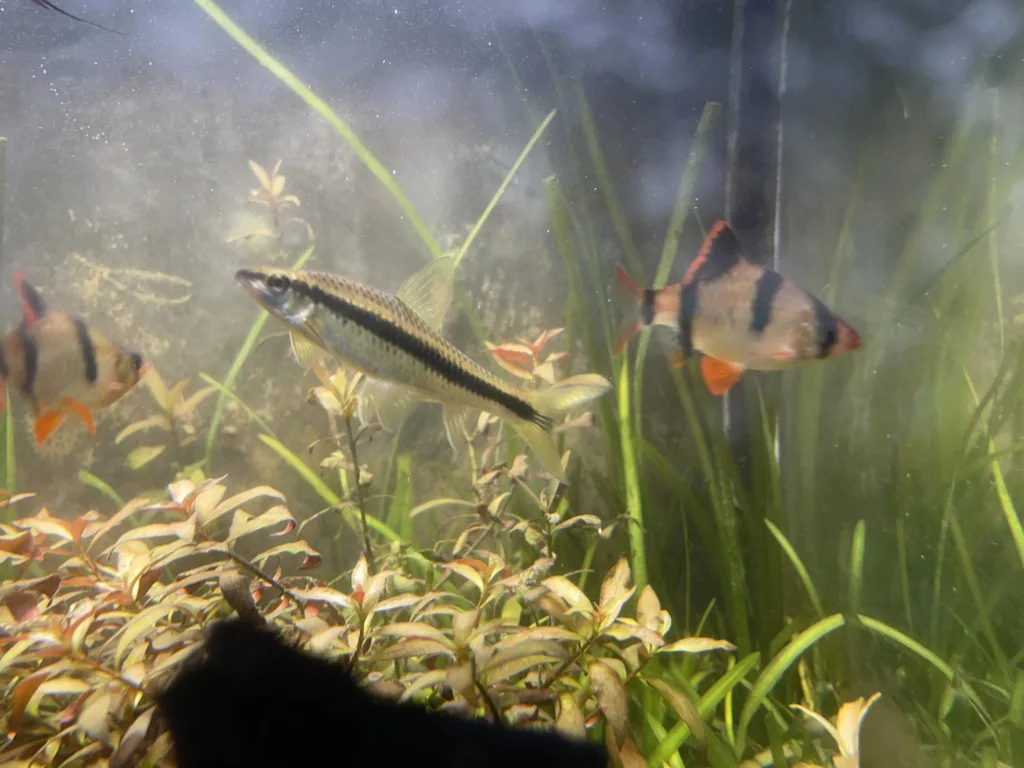
Finding the perfect tankmates for Roseline Sharks has been an essential part of creating a harmonious and dynamic aquarium. The compatibility of species within a tank is crucial for the well-being of all inhabitants. Here, I’ll share my personal experiences and tips on building a peaceful community aquarium that thrives.
Suitable Tankmates for Roseline Sharks
From my time caring for Roseline Sharks, I’ve learned they do exceptionally well with a variety of peaceful, similarly sized fish. Tetras, Rasboras, and even some types of Barbs can coexist beautifully with Roseline Sharks. These fish share a similar temperament and have an active lifestyle without being aggressive.
I’ve also had success with bottom dwellers like Corydoras or Otocinclus, which add another layer of interaction in the tank without competing for space with the Roseline Sharks.
Potential Aggression Issues and How to Mitigate Them
Though Roseline Sharks are generally peaceful, like any species, they can show signs of territorial behavior, especially in male-to-male interactions. To mitigate any aggression, I ensure there’s plenty of space and hiding spots in the tank.
Having a larger school of Roseline Sharks can also diffuse aggressive behavior, as it spreads any dominance challenges across the group rather than targeting a single individual. Adequate feeding and maintaining a stress-free environment are key strategies I’ve used to promote peace within the tank.
Ensuring Harmony in a Community Aquarium Setting
Creating a community aquarium that houses Roseline Sharks alongside other species is a delightful challenge that requires attention to detail. Harmony is achieved by carefully considering the needs and behaviors of each species.
For instance, I avoid adding fish with long, flowing fins that might tempt nipping from more active species. Observing the aquarium dynamics closely after introducing new fish is crucial for early detection of any compatibility issues.
Regular health checks and maintaining optimal water conditions are practices that keep the tank environment stable and stress-free for its inhabitants.
Additional Considerations for a Balanced Ecosystem
- Importance of a Spacious Environment
Ensuring the aquarium is spacious enough to support the adult sizes of all species is fundamental. Overcrowding can lead to stress, heightened aggression, and health problems. A larger tank allows for more intricate aquascaping, which not only looks beautiful but provides essential hiding spots and territory for the fish.
- Observational Adjustments
The dynamics in a community tank can change, especially as fish grow. Being observant and willing to make adjustments, whether that’s rehoming a fish or modifying the tank setup, is part of responsible fishkeeping. It’s all about creating an ecosystem where every inhabitant has the space and resource they need to thrive.
- Community Feeding Strategies
Feeding a diverse group of fish requires a strategy to ensure everyone gets their share. I use a combination of surface, mid-water, and bottom feeder foods to cater to the preferences of all tankmates. This method prevents competition and ensures a nutritional balance across the community.
Crafting a thriving community aquarium with Roseline Sharks has been an incredibly rewarding part of my aquarist adventure. It’s a continuous learning process, where observing, adapting, and caring with intention leads to a harmonious and vibrant aquatic life.
Health and Disease Management
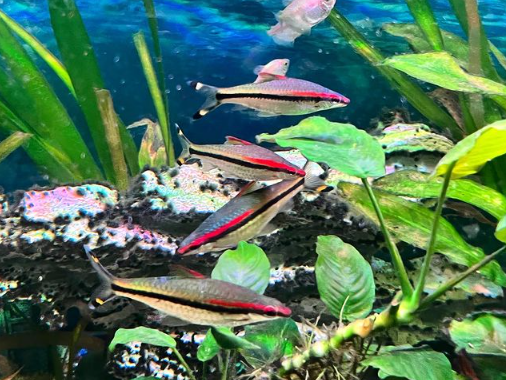
Source: @joanne_arms66
In my joyful and enriching journey as an aquarist, giving Roseline Sharks a healthy and vibrant life has always been my top priority. Understanding their health and managing potential diseases is crucial for their well-being. Here, I’ll share my firsthand experiences and insights on keeping these beautiful creatures in their best health.
Common Health Issues in Roseline Sharks
From my observations, Roseline Sharks are relatively hardy but can fall prey to common freshwater ailments such as ich, fin rot, and fungal infections.
Maintaining their environment is key to preventing these issues, but despite our best efforts, they may still occur. Recognizing them early is crucial for effective treatment.
Signs of Illness and Stress
The first signs that indicate something is amiss with a Roseline Shark can be subtle. Watch for changes in behavior, such as diminished appetite, lethargy, or hiding more than usual.
Physical signs might include cloudy eyes, frayed fins, or unusual spots on their body. These signals are integral in identifying stress or illness early on.
Preventative Measures and Treatment Options
Preventative care is paramount. I make regular water changes and monitor water parameters to create a stable environment. Quarantining new fish prevents the spread of disease into the tank.
Should illness arise, I turn to treatments such as quarantine tanks and medicated baths, precisely following treatment guidelines to not harm the fish or disrupt the tank’s ecosystem.
Stress Management Practices
Stress management is an often overlooked but essential aspect of fish health. I’ve found that providing plenty of hiding spaces, maintaining a consistent light cycle, and avoiding overcrowded conditions greatly reduce stress levels, leading to healthier, happier Roseline Sharks.
Regular Health Checks and Maintenance
Implementing a routine for health checks and regular tank maintenance is a game-changer. I regularly inspect each fish and keep an eye on water quality, filter function, and temperature consistency.
This proactive approach helps nip potential health issues in the bud, ensuring a thriving aquarium.
Navigating the health and disease management of Roseline Sharks has been a process filled with learning and growth. By sharing my experiences, I hope to inspire and nurture a nurturing approach to aquarium care, fostering a harmonious and disease-free environment for these exquisite fish.
Remember, the key to their health lies in our hands – through vigilant care, observation, and a deep commitment to their wellness, we can ensure our Roseline Sharks flourish.
Breeding Roseline Sharks
Breeding Roseline Sharks in a home aquarium is a captivating adventure, blending patience with excitement. It’s a path I’ve ventured down with a heart full of enthusiasm and a mind eager to learn. Here’s what I’ve discovered along this remarkable journey:
Breeding Behavior
Observing the courtship dance of Roseline Sharks is truly a sight to behold. Males often display vibrant colors, chasing females in a playful yet persistent manner. This ritual can go on for days, culminating in the release of eggs for fertilization.
Identifying these behaviors early on is key, allowing for preparations to ensure the eggs have the best chance of survival.
Tank Setup and Conditions for Breeding
Creating an ideal breeding environment is crucial. I opted for a separate breeding tank, mimicking their natural habitat with a temperature of around 77°F and slightly acidic to neutral pH levels.
The addition of fine-leaved plants and a soft substrate encouraged the deposition of eggs, setting the stage for the magic of life to unfold.
Care of Fry and Rearing Process
The moment fry emerge, the real work begins. Initially, they require infusoria-sized foods, gradually transitioning to micro worms and brine shrimp as they grow.
I found maintaining impeccable water quality and providing a varied diet essential for their development. Witnessing the transformation from fry to juvenile Roseline Sharks is nothing short of magical, a testament to nature’s wonders in our very homes.
Monitoring Growth and Health
Regular checks on the fry’s growth and health have been paramount. It’s fascinating to see individual personalities and traits emerge even in these early stages.
Keeping a watchful eye for any signs of distress or illness ensures I can act swiftly, maintaining an environment conducive to health and growth.
Integrating Juveniles with the Community
The final challenge in this breeding endeavor is the careful integration of juveniles back into the main tank or rehoming them.
This step requires assessing the tank’s dynamics to avoid overcrowding and ensuring the juveniles are large enough not to be perceived as prey by larger tank mates. It’s a delicate balance, blending the joys of successful breeding with responsible fishkeeping.
Breeding Roseline Sharks has enriched my life, adding depth to my passion for aquascaping and fishkeeping. It’s a process filled with trials and triumphs, each step forward a lesson learned.
I share this story not just as a guide but as an invitation to explore the wonders of aquatic life. May your own breeding adventures bring you as much joy and fulfillment as mine have.
Tips for Responsible Ownership
Researching Before Purchasing Roseline Sharks
Before adding Roseline Sharks to your aquatic family, it’s crucial to arm yourself with knowledge about their care requirements and natural habitat.
I spent countless hours digging into articles, forums, and speaking with seasoned aquarists to understand what it truly means to care for these lively beings.
This preparatory step is instrumental in setting both you and your Roseline Sharks up for a harmonious life together.
Providing Proper Care and Attention
Roseline Sharks thrive in environments that closely mimic their natural habitats. Ensuring the right tank conditions—from water quality to tank mates—is not just a responsibility but a commitment.
In my own experience, dedicating time each day to monitor their health, behavior, and tank conditions has been key to their flourishing. It’s a nurturing process, one that rewards with vibrant aquatic life and a serene underwater spectacle.
Contributing to Conservation Efforts
Learning about the Roseline Sharks led me to realize the importance of conservation efforts for these magnificent creatures and their ecosystems.
Supporting sustainable practices, adopting from reputable sources, and educating others about the importance of conservation have become integral parts of my journey as an aquarist.
It’s about giving back to nature, preserving the vibrant biodiversity of our planet for future generations to cherish.
Engaging with a Community of Fellow Aquarists
One of the most enriching aspects of owning Roseline Sharks has been connecting with a community of like-minded individuals. Sharing experiences, challenges, and triumphs with fellow aquarists has not only broadened my knowledge but also deepened my appreciation for the hobby.
It’s a vibrant community, eager to support and inspire each other in our collective quest for responsible and rewarding fishkeeping.
Continuously Learning and Adapting
Finally, the world of fishkeeping is ever-evolving, and so should we. My adventure with Roseline Sharks has taught me the importance of ongoing learning and adaptation.
Whether it’s a new piece of equipment, a better understanding of their dietary needs, or innovative conservation techniques, there’s always room to grow. It’s this perpetual curiosity that keeps the passion alive, fueling a deeper connection with our aquatic companions.
In sharing these insights, I hope to inspire both current and future Roseline Sharks enthusiasts to approach fishkeeping with enthusiasm, knowledge, and a nurturing spirit.
Remember, responsible ownership is a voyage, one that’s as rewarding as it is enlightening. Together, we can ensure these beautiful creatures thrive under our care while contributing to the larger ecosystem they call home.
Frequently Asked Questions (FAQs)
Q: How difficult is it to breed Roseline Sharks?
A: Breeding Roseline Sharks can be a challenging but rewarding process. It requires careful monitoring, appropriate tank conditions, and a good understanding of their behaviors and needs. However, with the right preparation and dedication, it’s possible for aquarists of all levels.
Q: Can I keep Roseline Sharks with other fish?
A: Yes, but it’s essential to choose tank mates carefully. Larger and more peaceful species, such as tetras or gouramis, make better companions than smaller or aggressive fish. It’s also important to provide adequate hiding spots and monitor interactions closely.
Q: Do Roseline Sharks require a large tank?
A: Yes, they are an active species that can grow up to six inches. A tank of at least 40 gallons is recommended for a small group. Providing enough swimming space and maintaining water quality is crucial to their well-being.
Q: Are Roseline Sharks endangered?
A: No, they are not currently listed as endangered. However, due to habitat destruction and overfishing in their native range, it’s important to support sustainable practices and avoid purchasing wild-caught specimens.
Q: Can I breed Roseline Sharks for profit?
A: While breeding Roseline Sharks can be a profitable venture, it’s essential to consider the responsibility that comes with it. Responsible fishkeeping should always come first, and any potential profits should not compromise the well-being of the fish. EndFragment
Keep learning, growing, and sharing your experiences with others. Together, we can ensure responsible ownership of Roseline Sharks for generations to come while marveling at their beauty and vibrancy in our own aquatic sanctuaries. Happy fishkeeping! EndFragment
Thank you for reading this guide on breeding Roseline Sharks. I hope it has sparked your interest and provided valuable insights into responsible fishkeeping. Don’t hesitate to reach out to the vibrant community of aquarists for further support and guidance on this journey. See you in the underwater world!
